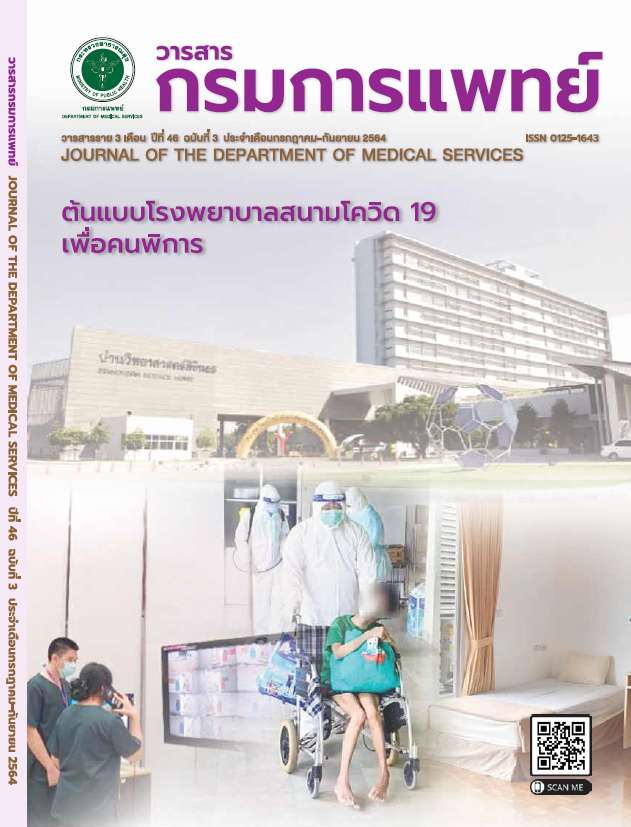Result of Reporting Cytology of Salivary Gland According to Milan System in Five-year Achieves of Rajavithi Hospital
Keywords:
Salivary gland, FNA, The Milan System for Reporting Salivary Gland CytopathologyAbstract
Background: The Milan System for Reporting Salivary Gland Cytopathology (MSRSGC) is a reporting system for Fine-needle aspiration cytology (FNAC) to diagnose and manage salivary gland tumors. MSRSGC is a six-tier classification that provides a standardized terminology and ROM for each category, thus avoiding ambiguity in FNAC interpretation.Objective: The present study was conducted to evaluate the risk of malignancy by applying the Milan system to diagnose salivary gland lesions in the institute.Method: The study was a retrospective study for risk of malignancy with cytohistological correlation by applying Milan System in the department of pathology at Rajavithi hospital for five years. The salivary gland FNAC cases were reviewed and divided into six categories per the proposed Milan system for reporting salivary gland cytopathology. The cases with available histopathology were further consolidated according to the proposed Milan system, and the risk of malignancy were calculated.Results: The number of cases in each category was Non- diagnostic 26.4%, Non-neoplastic 20.6%, AUS 6.5%, Benign neoplasm 34.7%, salivary lesions of uncertain malignant potential (SUMP) 14.1%, Suspicious for malignancy 11.9%, and malignant neoplasm 11.9%. The risk of malignancy for each category was 15.8% (Non- neoplastic), 33.3% (AUS), 12.5% (Benign neoplasm), 53.8% (SUMP), 90.9% (Suspicious for malignancy), and 90.9% (Malignant neoplasm).Conclusion: MSRSGC is a useful system for risk assessment. It is an effective protocol to differentiate benign from malignant tumors, especially for categories V and VI. Our findings also suggest that in addition to the surgical follow-up, the inclusion of the clinical and radiological follow-up may be a better strategy for the calculation of risk of malignancy, especially for categories IVB (SUMP).
References
Faquin WC, Rossi ED, Baloch Z, Barkan GA, Foschini MP, Kurtycz DFI, et al. The Milan System for Reporting Salivary Gland Cytopathology.Springer International Publishing AG 2018; 1st ed:1–182.
Sundling KE, Kurtycz DFI. Standardized terminology systems in cytopathology. Diagn. Cytopathol 2019; 47: 53-63.
Rossi ED, Faquin WC, Baloch Z, Barkan GA, Foschini MP, Pusztaszeri M et al. The Milan System for Reporting Salivary Gland Cytopathology: Analysis and suggestions of initial survey. Cancer Cytopathol 2017; 125:757–66.
Rossi ED, Faquin WC. The Milan System for Reporting Salivary Gland Cytopathology (MSRSGC): An international effort toward improved patient care-when the roots might be inspired by Leonardo da Vinci. Cancer Cytopathol 2018; 126: 756–76.
Hughes JH, Volk EE, Wilbur DC. Pitfalls in salivary gland fine-needle aspiration cytology: Lessons from the College of American Pathologists Interlaboratory Comparison Program in Nongynecologic Cytology.Cytopathology Resource Committee; College of American Pathologists. Arch. Pathol. Lab. Med. 2005;129:26–31.
Chowsilpa S, An D, Lose H, Huang X, Nayar R, Maleki Z. Risk of malignancy associated with cytomorphology subtypes in the salivary gland neoplasm of uncertain malignant potential (SUMP) category in the Milan System: A bi-institutional study. Cancer Cytopathol; 2019.
Rohilla M, Singh P, Rajwanshi A, Gupta N, Srinivasan R, Dey P, et al. Three-year cytohistological correlation of salivary gland FNA cytology at a tertiary center with the application of the Milan system for risk stratification.Cancer Cytopathol. 2017;125:767-75.
Pusztaszeri M, Reis-Filho JS, Schmitt FCdL, Edelweiss M. Ancillary studies for salivary gland cytology. In: Faquin WC, Rossi ED,Baloch Z, et al, eds. The Milan System for Reporting Salivary Gland Cytopathology. Basel,Switzerland: Springer International Publishing; 2018:139-55.
Eytan DF, Yin LX, Maleki Z, Koch WM, Tufano RP, et al. Utility of preoperative fine needle aspiration in parotid lesions. Laryngoscope.2018;128:398-402.
Layfield LJ, Glasgow BJ. Diagnosis of salivary gland tumors by fine-needle aspiration cytology: a review of clinical utility and pitfalls. Diagn Cytopathol. 1991;7:267-72.
Downloads
Published
How to Cite
Issue
Section
License

This work is licensed under a Creative Commons Attribution-NonCommercial-NoDerivatives 4.0 International License.
บทความที่ได้รับการตีพิมพ์เป็นลิขสิทธิ์ของกรมการแพทย์ กระทรวงสาธารณสุข
ข้อความและข้อคิดเห็นต่างๆ เป็นของผู้เขียนบทความ ไม่ใช่ความเห็นของกองบรรณาธิการหรือของวารสารกรมการแพทย์



